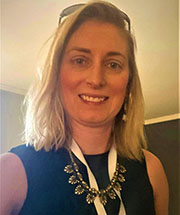KU leading project to test new business model for rural, weekly newspapers
LAWRENCE — Business has changed since 1833. One would be hard-pressed to find businesses operating with the same model that was in place when Andrew Jackson was in the White House. But in the case of newspapers, many are still operating with the same business model established when Benjamin Day opened the first penny press nearly 200 years ago. A University of Kansas professor of journalism is leading a project to test a new model based on research with publishers and readers to help rural newspapers adapt, survive and thrive.
During the COVID-19 pandemic, Teri Finneman, associate professor of journalism at KU, took part in an oral history project to help document the experiences of rural, weekly newspapers.

“We saw during the pandemic how absolutely critical it was to have a local news source. You couldn’t get community-specific news about COVID anywhere else,” Finneman said. “At the same time, we saw newsrooms closing. It hit me that this is the time to look at a new business model.”
This summer, the project will implement and test a model that moves away from heavy reliance on advertising and cheap subscriptions. After a year of testing, if the new model is successful in use of memberships, e-newsletters, events and new content direction, plans call to distribute a new model available for rural weeklies across the country. The research is funded through an innovation grant from KU's William Allen White School of Journalism & Mass Communications and support from the Southern Newspaper Publisher Association and North Dakota, South Dakota, Nebraska and Kansas Newspaper Associations.
Finneman and research partners Pat Ferrucci of the University of Colorado-Boulder and Nick Mathews of the University of Minnesota conducted surveys with 132 publishers from the Great Plains states, primarily from newspapers in communities with populations of 3,000 or fewer. The publishers were presented with 15 potential revenue streams and asked which they would be willing to try. Respondents said they were most receptive to the traditional threads of advertising, subscriptions and legal notices. The least popular options were memberships, e-newsletters, government support and large private donations.
More than 400 readers in rural areas of these states were given a similar survey, asking in what ways they would consider supporting their local newspapers. Memberships, events and e-newsletters were among the most popular responses.
“We found there’s a tremendous disconnect between what readers say they are willing to support and what publishers are willing to consider,” Finneman said. “This business model we’re testing is all about being proactive if the day comes when newspapers lose another revenue source in legal notices, having a safety net in place and evolving.”
Forty percent of readers also indicated that they would be very likely or likely to donate, in addition to subscription costs, to their local newspaper. Finneman said the concept does have precedent in the United States, as both public television and radio receive government support and private support through donations.
In terms of the type of content they wanted to see, readers indicated they were most interested in reading about local events, feature stories and obituaries. They were least interested in reading opinion pages, which Finneman said is understandable in the age of social media, where opinion is available everywhere.
“People just want to read good news. We’ve heard that for years, but especially during the pandemic, that point was driven home,” Finneman said. “We heard time and time again that people just want to read some good news and about things to do in their community.”
The research team is now in the process of implementing the new business model with Kansas Publishing Ventures, which owns and operates Harvey County Now in Newton and the Hillsboro Free Press in Hillsboro.
Publisher Joey Young and the researchers are determining how the new model will be implemented and speaking with community members in the papers’ readership area, as well as with press groups and communities throughout the Great Plains states. The model will include memberships in which readers can receive tiered benefits. The model will also work to engage community members, especially young residents, and focus on preferred reader content.
In focus groups in which researchers presented publishers with results of reader surveys and discussed potential new approaches, participants indicated a reluctance to accepting donations or government support. While many countries include government support for media, the model for this study will begin with a focus on memberships, in which readers can offer additional support.
“There was a lot of caution about trying something new, and a lot of concern about a lack of time, as opposed to the potential to make more money and add resources to address a lack of time, while continuing to serve their communities,” Finneman said, adding that, if even 25 or 30% of readers elected to pay more through memberships, the revenue increase could be significant.
As the new model is tested, the research team and local publisher will conduct both publicity and educational outreach efforts to help inform local readers of the changes, how they work, the benefits, reasons behind the move and more. While the project is underway, the research team will also produce an oral history of the project, its implementation and potential to transform the industry that will be housed at the Kansas Historical Society.
Finneman, who with KU journalism students publishes the Eudora Times, said the project is intended to revive community journalism’s business model and also to prevent news deserts from spreading. The project is also intended to help boost connections between community newspapers and their readers. In one state, 63% of respondents said they did not know anyone at their local newspaper office but also indicated they would be twice as likely to give financial support to their local paper if they did know a journalist, editor or publisher.